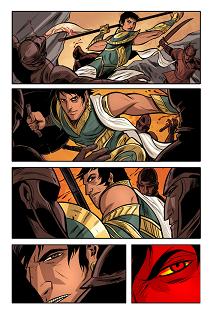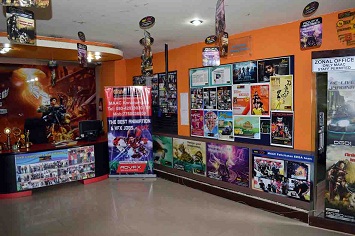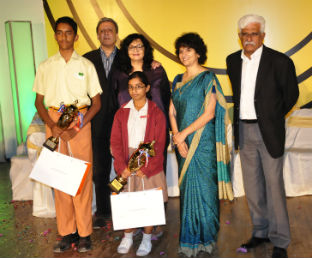Move Over Hellboy, Chakra Is Here
Oct 11, 2019, 11 25 | Updated: Oct 11, 2019, 11 25
A Bangalore company has turned a genius teenager from Mumbai into a superhero. They showed a regular girl in small-town India to fight demons with her super human powers. They took a time machine to the year 3392 to create a stylised futuristic take on The Ramayana.
Graphic India, a Bangalore based company, launched in 2012 by media entrepreneurs Sharad Devarajan, Gotham Chopra and Suresh Seetharaman specialises in creating new, exciting, contemporary leading characters, comics and stories for the Indian youth market.
Something about the dark and mature undertones in the content and a colourful display of illustration, hugely appeals to the younger demographic. Maus, Watchmen and Dark Knight Returns are some of the successful graphic novels of all times. Popular artists and writers like Frank Miller, David Mazzuccheli, Mark Miller and Art Spiegelman are all globally renowned for their fabulous body of work in the comic books space.
The west has capitalised on its huge collection of sci-fi subjects and super heroes. Superman, Batman, Hellboy, Avengers etc. have led the comic industry laughing all the way to the bank as they have been the subjects of the most popular graphic novels over the past decade. Comic book giants Marvel and DC have partnered with the best artists, writers and illustrators to create some really memorable and successful graphic novels. A multibillion-dollar industry in the US, It’s only recently that the graphic novel phenomenon has gained some momentum in India.
Bollywood is looking at graphic novels seriously and using them to market its films. There have been cases, where the comic has generated such a positive response that the creators decided to make it an on-going series. Case in point, the ‘Don’ comic books, which were released before the film. The purpose was to generate curiosity and market the movie in a new, innovative way. But the comics became very popular with young folk and are now a regular series on their own merit. Some other recent examples of film characters in comic books are Agent Vinod, Krrish and Ra. One.
A major boost for the graphic novels in India has been the super success of the recently concluded ‘Comic Con India,’ which took place in New Delhi (also scheduled to happen in Bangalore on 1st and 2nd June, 2013). The three-day event had close to 100 participants and numerous talks and interactive sessions by renowned artists. It was a huge platform for artists, publishers, like-minded enthusiasts and comic lovers of all ages to come together and share their interests. The huge turnout at the event further proved the scale and potential of comics and graphic novels to do well in India.
In India, entertainment targeted primarily at kids and young adults is more often than not related to mythology. But there’s more to the young Indian mind than stories of Rama and Arjuna. It is this need that Graphic India seems to fulfil.
Graphic India intends to launch numerous new projects in the upcoming year showcasing original stories from young breakthrough talent as well as established Indian and global artists. In addition to these several new properties in production, Graphic India aims to release new digital content around the highly acclaimed comic books previously published including:
Chakra – From the brilliant mind of Stan Lee, who gave the world characters such as Spiderman, Ironman, The Avengers etc. comes the Indian superhero Chakra. The story centres around a simple Mumbai teenager Raju Rai, who develops a technically enhanced suit that activates the mystical Chakras of the body, unleashing newfound abilities and powers.
Devi -Created by filmmaker Shekhar Kapur, features the story of an immortal goddess reincarnated as a young woman in the fictional Indian city of Sitapur, who uses her super-heroic powers to save her city from demons and monsters.
The Sadhu -Created by best selling author, Gotham Chopra, is about a British colonial soldier who is trained by the Indian mystics known as sadhus and uses his newfound abilities (a Shiva-like wave of energy through the third eye on his forehead) for justice. The concept is also currently being developed as a live-action Hollywood film.
Ramayan 3392AD - A futuristic epic inspired by the classical Ramayana myth and currently being developed as a theatrical live-action film in Hollywood.
--------------------------------------------------------------------
Interview
Sharad Devarajan, Co-founder, Graphic India
Sharad Devarajan has an enviable job indeed. Prior to developing Graphic India, Devarajan was the CEO and publisher of Virgin Comics and Virgin Animation a set of companies he co-founded, with Sir Richard Branson, authors Deepak Chopra and filmmaker Shekhar Kapur. In 2004, Devarajan worked with Marvel recreating Spider-Man as an Indian boy growing up in Mumbai, transforming ‘Peter Parker’ into ‘Pavitr Prabhakar.’ Unlike traditional translations of western characters for foreign markets, the new series, ‘Spider-Man: India’ was heralded as one of the industry's first ‘trans-creations.’
Devarajan is also a Producer / Executive Producer on a number of Hollywood live-action films and television projects in development including the film adaptation of Gamekeeper with director Guy Ritchie; The Leaves with Summit Entertainment; First Family with Fremantle Media Enterprises; Dinner With Deepak with author Deepak Chopra.
What kind of a facility do you have here in Bangalore?
We just formed the company a few months back and are building out a core team and studio here in Bangalore or amazing ‘black belt’ artistic ninjas who can take on anyone in the world in terms of quality and creativity. However, we also believe very much in a virtual business model where we bring in some of the best creators from around the world to work on different projects. The old models of building large in-house teams are irrelevant in a world of Skype and Dropbox.
Why Bangalore as the base for Graphic India?
There is a strong entrepreneurial culture in Bangalore that promotes an anarchist spirit in the way we try and disrupt existing businesses with new ideas. Bangalore is the home to digital innovation and start-ups and the prefect base of operations for us.
Where do you think India currently stands in terms of the comic book industry?
Comic books and graphic novels are a powerful medium to create stories, characters and worlds regardless of the genre or demographic. In the earlier part of the decade, in India, comics were still perceived as ‘kids products’ whereas in the last five years a new generation of world-class Indian creators have begun expanding the boundaries of the medium. We believe a creative renaissance is emerging in the country. Many of the creators I have been fortunate enough to work with such as Jeevan J. Kang, Edison George, Mukesh Singh, Samit Basu, Saurav Mohapatra and Saumin Patel are developing tremendous interest around the world for their work.
However, India has created a reputation as one of the leading animation service providers in the world and while that has created numerous studios and opportunities, outsourcing has been a double-edged sword since it has inhibited the potential of the country to really develop its own strong indigenous character entertainment industry of which comics and animation are both interconnected. Our mission at Graphic is to transform the perception of India from an ‘outsourcer’ to ‘a source.’ After all it wasn't just Japanese kids who made Pokemon a success, it was every kid. One Japanese character such as that has generated billions in revenue - more than the GDP of certain countries, but more importantly it fostered the imagination and creativity of millions of children in the world. Often when I speak to students at Indian art schools I remind them that all it takes is one kid in India with a pencil, paper and a dream to create the next great character that will change the world.
The success and brilliance artists at Graphic is not in their drawing ability, but the way they think and see the world. They create and innovate as "artists" not as "technicians."
With a prominent figure like Stan Lee on at the helm for Chakra, do you see that character fighting the forces of evil alongside the Avengers sometime soon?
While that would be something very fun to be a part of, for us its probably more exciting to take Stan Lee, who is probably the single most influential creator alive today in the western superhero genre and have him work with our Indian creators to develop an entirely new hero that tries to take ideas from the east and west and synthesize them into something new – possibly kicking off our equivalent of the Avengers of Asia that create new heroes that connect with audiences in new ways.
The western superhero was really defined in the 60s by Stan and his creative partners and largely influenced by the cold war ethos and atomic age of ‘Man Versus Science.’ Spider-Man, X-Men, Hulk, Fantastic Four, Daredevil get their powers from mutations or unknown radiation that played on the unknown powers of radioactivity during that time.
Characters like the X-Men dealt with strong allegorical social issues such as racism and the themes of separatism versus inclusion, which were often being reflected in the political dialogue of the Civil Rights Movement.
Similarly, many Japanese comics & anime were defined early on by ‘Man versus Nature’ (seen in Akira, Godzilla, Princess Mononoke, etc.), where industry disrupts man's balance with nature and leads to post apocalyptic wastelands.
In the same way at Graphic we hope our stories allow Indian creators to tap into their cultures and prevailing contemporary issues, hopes, dreams and fears to serve as the source of inspiration for their characters and stories and if done right I believe these themes start to resonate and catch like wildfire on a global level
A noticeable trend in recent times has been Bollywood’s interest in the comic book and graphic novel industry, comics based on popular film characters such as Don, Krissh and Agent Vinod (all recent Hindi films with big stars) being developed and circulated widely. Your views on this trend?
At its core a comic book is a visual storytelling experience akin to a movie with an unlimited budget. A medium where an artist and writer can conceive of spectacular visual narratives without the constraints we find in other mediums, so the raw imagination of comic books is what makes them so compelling. So its only natural that filmmakers and producers have looked at comic books as a natural extension of the type of cinematic visual experiences they like to tell. If the characters are compelling and the film offers a rich world that can be expanded with new stories, I think it makes a lot of sense to explore these opportunities – in the end the consumer wins and gets more ways to engage with the stories they love.
International graphic novels and DC, Marvel comics are immensely popular in India. The illustrations here are definitely at par with international standards but what makes you sure that the resource pool in India has the ability to develop the kind of content (story and scripts) the new age Indian youth can connect with?
Our comics and creators will stand toe-to-toe with the best content produced anywhere in the world and their work will instil a sense of national pride for all Indians as the country sees its myths, heroes and stories become global phenomenons.
We also believe its about pairing up great talent from east and west. For example, internationally we released a beautiful hardcover book inspired by The Mahabharata, called ‘18 Days.’ It takes one of the most enduring tales of the East and places it in the adept hands of Grant Morrison, one of the greatest comic book storytellers of the West. Combined with the visual spectacle of superstar artist Mukesh Singh's brilliant art, this is a book that goes beyond myth, beyond generations and beyond borders. Think Lord of the Rings meets Avatar and then times that by ten.
When we launched this book in the States it was mainly purchased by audiences who were not Indian or familiar with the original myth – they just felt it was a great epic story.
-------------------------------
“Bangalore has a very cosmopolitan group of people and since it is a technology center and the emerging city of India it makes perfect sense for us to be here as Graphic is going to play a very aggressive digital role in content creation.”
- Suresh Seetharaman, Co-Founder, Graphic India







